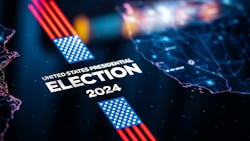What will Trump’s second term mean for dentistry?
Before we dive into how a second Trump administration could affect the dental industry, it’s worth noting that many campaign promises never come to pass. President-Elect Donald Trump is particularly known for being flexible, if not unpredictable, in his policy approach.
Trump will also have the advantage of a strong Republican majority in both the House and Senate. The last time a president enjoyed that kind of policy advantage was when Obama passed the Affordable Care Act (ACA) in 2010.
While everything is still up in the air, here are several key ways Trump’s stated policy agendas could affect dentistry.
Water fluoridation: Potential changes ahead
Trump has promised to give Robert F. Kennedy Jr., a lawyer and longtime critic of the FDA and water fluoridation, broad authority to make health-related reforms in his administration, although it’s not yet clear what his role will be. In the wake of Trump’s victory, Kennedy has already said Trump’s administration will recommend ending community water fluoridation.
Even prior to the election, it’s been a tough year for proponents of community water fluoridation. A California court ruling directed the EPA to issue a regulatory response to water fluoridation due to “an unreasonable risk of injury” from the practice.
Anecdotally, in my conversations across the profession, I have noticed an increasing skepticism about water fluoridation and even fluoride more generally. For their part, the ADA and the AAP have said their recommendations have not changed.
ACA changes and dental insurance coverage
Dental coverage and access have been somewhat removed from the national debate over the 2010 Affordable Care Act, also known as Obamacare, which did not explicitly mandate changes to dental coverage.
Trump tried and failed to repeal the Affordable Care Act in 2017; he has indicated he won’t push for a broad repeal in his second term, but rather change certain aspects of the law.
Even though the ACA did not directly address dental insurance coverage, a 2021 study published in the International Journal of Environmental Research and Public Health found that the law had a “spillover” effect on dental care: “this review of studies conducted so far clearly showed that the ACA resulted in gains in dental care coverage for adults and children, but there were mixed results on its impact on dental care access or utilization.”
However, since the passage of the ACA and Trump’s 2017 attempt to repeal it, adding a dental benefit to Medicare has become extremely popular, with nine out of 10 voters supporting it, according to the CareQuest Institute.
New tax policy's impact on dental M&A
Capital gains, corporate, and estate taxes are all relevant to individual practice owners and DSOs and impact the dental merger and acquisition market.
Kyle Francis, founder and president of Professional Transition Strategies, recently told Dental Tribune International that the dental M&A market has traditionally weathered changes in political administrations, interest rates, and inflation well, and stated he did not anticipate a slowdown during this period of political uncertainty.
In a September Dental Economics article, managing director of Tusk Practice Sales Ryan Mingus characterized Trump’s proposed tax policies as largely more favorable to dental practice owners looking to sell.
The American stock market has surged since the election was called for Trump, indicating investors see his administration as a more business-friendly one.
Tariffs and the dental supply chain
During his first term, Trump made ample use of the tariff, a tax that had been in disuse since the second world war. The Biden administration largely left those tariffs in place. These tariffs strained relationships with some trading partners and led to some retaliatory tariffs on American goods.
For his second term, Trump has proposed more monumental changes, including a 10%–20% tax on all imports, with a higher 60% tariff for goods from China. He has stated that these tariffs would encourage companies to bring manufacturing back to the United States and generally protect the US from competition abroad.
Even though they have significant foreign policy implications, at the end of the day tariffs are simply another form of tax. However, because the increase in cost is passed along to the consumer in the final price of the product, they often aren’t talked about by everyday Americans.
During the pandemic, the United States’s reliance on Chinese-made personal protective equipment came into sharp view, but little has changed since then. At the time, there was an increase in American-made PPE in the market, but after supply chain issues eased, many could not compete with Chinese-imported goods. These tariffs would make it more expensive for dental manufacturers to import supplies. Items manufactured in the United States could become more competitive, but increasing factories in the US would take time.
After the vote, a vibe check
What are your top business priorities now that we know the outcome of the presidential election? And are you confident in the future Trump administration’s approach to key economic issues? Let us know via this quick six-question poll of B2B leaders! We look forward to sharing the results with you soon.
More coverage
Several other publications owned by DentistryIQ parent company Endeavor Business Media have also been writing about the presidential election's impact on their markets.
About the Author
Amelia Williamson DeStefano
Group Editorial Director
Amelia Williamson DeStefano, MA, is group editorial director of the Endeavor Business Media Dental Group, where she leads the publication of high-quality content that empowers oral-health professionals to advance patient well-being, succeed in business, and cultivate professional joy and fulfillment. She holds a master's in English Literature from the University of Tulsa and has worked in dental media since 2015.
Updated May 16, 2023

